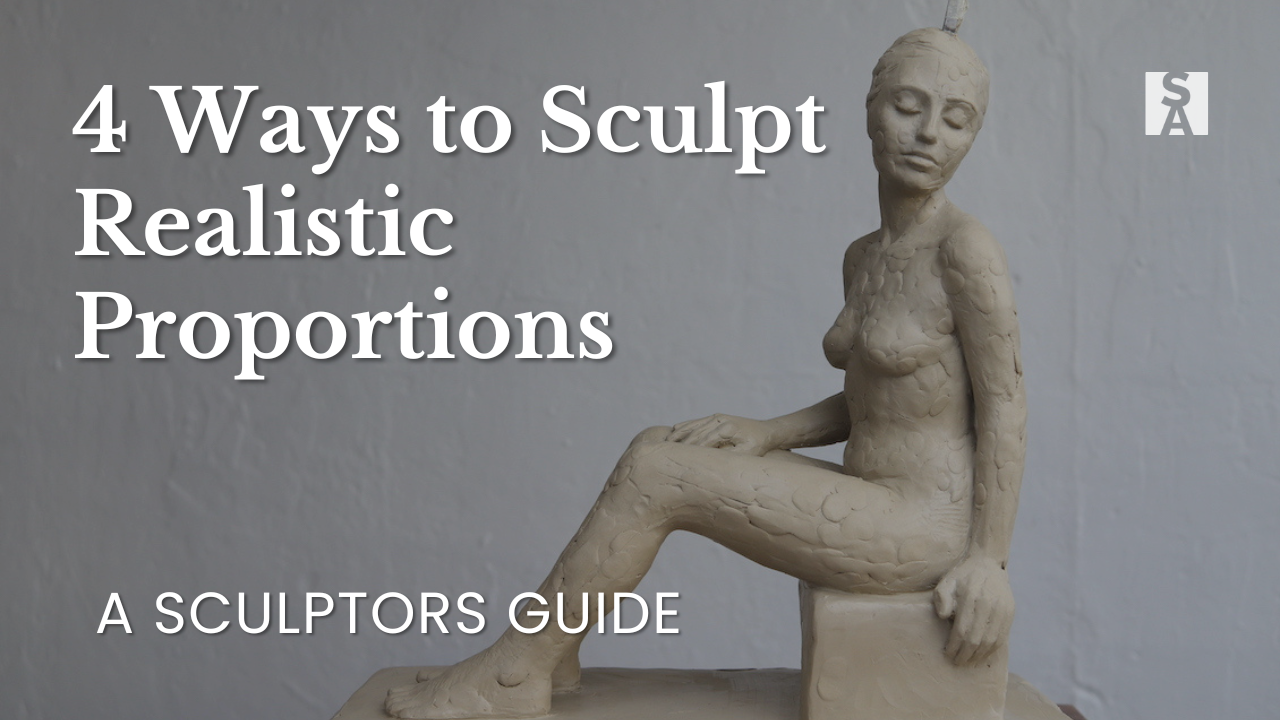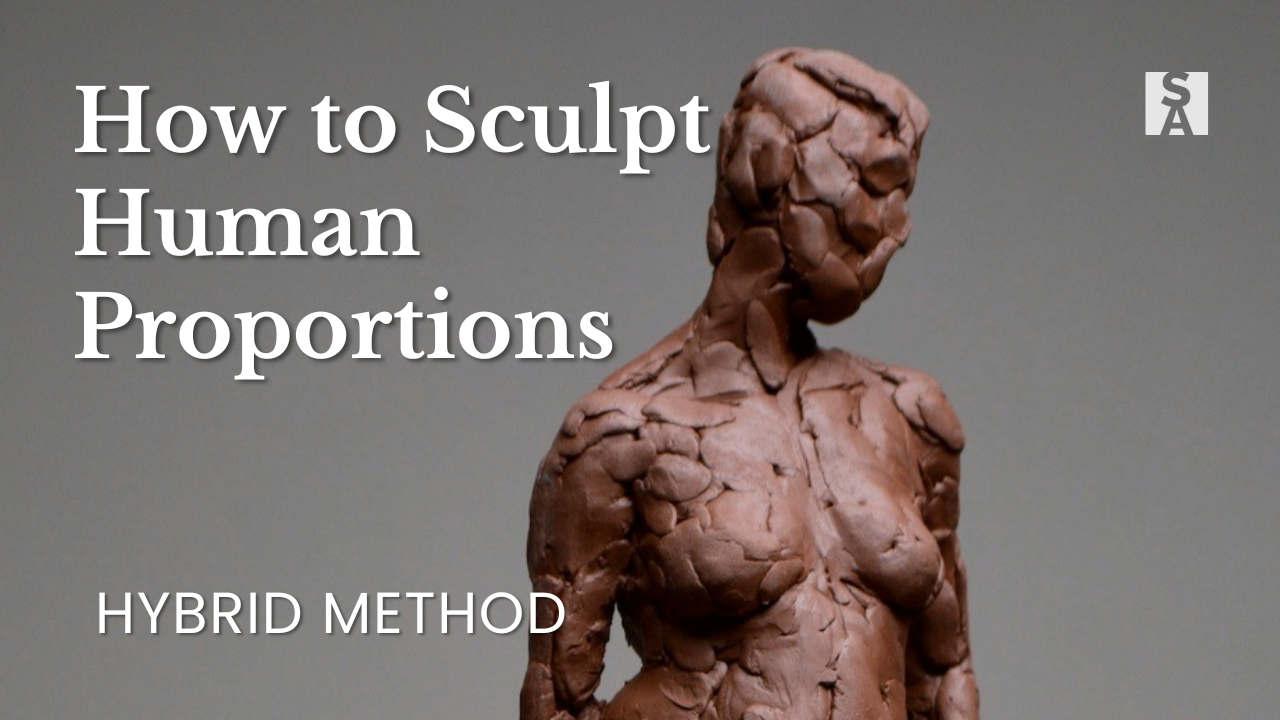How to Use a Canon of Proportions in Sculpture

If you’re trying to sculpt the human figure and wondering how to get your proportions correct - a canon of proportions is one of the oldest systems for solving this.
In this article, you’ll learn what a canon of proportions really is, the three main types sculptors use, when to apply them, and how to avoid the biggest mistakes artists make when relying on them.
This article is part of a 4-part series on how to sculpt realistic human proportions.
Explore the other methods here:
- How to Sculpt Realistic Proportions: Visual Observation for Sculptors
- Measuring Techniques for Accurate Proportions in Sculpture
- How to Sculpt Human Proportions with a Flexible Hybrid Approach (coming soon!)
Table of Contents
- What Is a Canon of Proportions?
- Idealistic vs. Realistic Proportions
- The Limits of Head-Length Canons
- When to Use a Canon of Proportions
- Common Body Ratios Every Sculptor Should Know
- Best Tool for Measuring Proportions in Sculpture
- Beyond Canons: 3 Additional Methods
- Ready to Apply This?
What Is a Canon of Proportions?

A canon of proportions is a set of standardized rules for constructing the human body. These systems have been used for thousands of years by the Egyptians, Greeks, Renaissance masters, and even modern figure sculptors.
At its core, a canon uses one part of the body (for example: the head) as a unit of measurement. The rest of the body is built out proportionally based on that unit.
Idealistic vs. Realistic Proportions in Sculpture
Not all canons are created equal. Here are the two most common types:
Idealistic Proportions: The 8-Head Canon

Image courtesy of the book: Andrew Loomis - Figure Drawing For All It's Worth.
Idealistic canons (like the classical 8-head figure) are designed to make the body look noble, heroic, or elevated. They tend to elongate limbs and heighten contrast, which is ideal for sculptures meant to inspire or symbolize.
Realistic Proportions: The 7.5-Head Canon

Image courtesy of the book: Artistic Anatomy by Paul Richer
Statistical or average-based canons (like 7.5-head systems) are grounded in actual human measurements, and they’re often used when realism is the goal. You’ve probably seen the “8-head” figure in reference books. But the average person is closer to 7.5 heads in height, as shown in Dr. Paul Richer’s illustration above. That distinction matters when your sculpture aims for lifelike proportions.
The Limits of Head-Length Canons in Realistic Sculpture
While the head systems have their place, they’re not the only way to approach figurative proportion. In fact, I don’t typically use head-length canons in my own sculpture or when teaching my students inside the Atelier program, because they rely on soft tissue landmarks that shift the moment the body bends or rotates.
Here’s an example: you are using the 8 head canon pictured above that relies on the distance from the nipple line to the navel… but your figure is bending forward so that distance is highly compressed. You can see how real-life application reduces the usefulness of that measurement.
Skeletal Unit Canons: A More Reliable Alternative
Not all canons rely on head-lengths. Some systems use skeletal landmarks—like the cranium, rib cage, or joint-to-joint distances—which tend to stay more consistent as the figure moves. These can be a lot more useful for sculptors than soft-tissue-based systems.

For example, Robert Beverly Hale taught a method that uses the cranium as the base unit, and compares it to the rest of the skeleton. This shifts the focus toward the bony structure of the body, rather than fleshy points that change with the moving position of the body.
What matters most when it comes to proportions is understanding how to use proportional tools when they’re useful, and when to use other methods. That’s why I teach students inside the Atelier to use a range of methods: including canons, direct measurement, and visual observation to determine realistic proportions.
The key is knowing what type of canon serves the pose or figure you're sculpting, and when to use it. That’s what we explore next.
When to Use a Canon of Proportions
Canons have an important role in figurative sculpture, especially when you're working without a reference or building foundational skills. They offer a clear structure for blocking in the figure and can help simplify the complexity of the human body.
Use a Canon of Proportion If:
- You’re working from imagination
- You don’t have a reference or model
- You want a reliable starting point to build from
They're especially helpful for beginning sculptors who want to first create work that looks human, before worrying about individuality or capturing likeness. Canons simplify the body into manageable segments.
Limitations of Canons of Proportions:
- Can make your sculpture feel generic
- Fleshy-point canons don’t apply to bodies in complex poses
- Not useful for capturing likeness or individuality
- Require memorization or a printed reference chart nearby
A canon of proportions is a tool - not law. It gives you a system to follow, especially when you don’t have a model or reference in front of you.
But it’s also where many sculptors get stuck, especially when they treat it as the only “correct” way to sculpt a figure. Inside the Atelier, I teach how to use these systems as a starting point, not a destination, because real mastery means knowing when to follow a system and when to respond to the form in front of you.
Common Body Ratios Every Sculptor Should Know
While a canon of proportions is a full-body system based on repeated units (like head-lengths), there are also individual anatomical ratios that are useful to know. These aren’t rigid rules, but common relationships that show up again and again in the human figure.

Image courtesy of the book: Artistic Anatomy by Paul Richer
Here are a few examples (why not take a moment to measure them on yourself and see how you compare):
- The average human is 7.5 heads tall
- Your legs are typically half the height of your body
- The hand is about the same length as the face
- Your foot is about the same length as your forearm
- The Rule of Thirds can be used to divide the face:
- Hairline to brow
- Brow to bottom of nose
- Nose to chin
These types of relationships give you reference points that are consistent and easy to measure whether you're sculpting from a photo, a live model, or imagination.
But if your goal is to create a portrait or a sculpture that feels like a real, specific individual, it's essential to combine these systems with direct observation and precise measurement techniques. Each method has its place, and when used together, they allow you to move from generic to truly lifelike.
Best Tool for Measuring Human Proportions in Sculpture
No matter which proportions you choose to use, there’s one physical tool that becomes essential to translating them onto your sculpture: the caliper.

Calipers are uniquely suited for sculptors because they’re designed to measure three-dimensional forms. Unlike a ruler or a tape measure, a caliper can reach around curves, compare distances, and maintain proportional accuracy in space.
Want the Tool Guide?
If you're just getting started and need the right tools (including calipers for proportions), get my free guide below:

Beyond Canons: 3 Additional Methods for Accurate Proportions in Sculpture
Canon systems are a strong starting point, but they’re not enough on their own. If you want to create sculpture that captures personality and individuality, you need to combine them with other methods. That’s why I teach sculptors how to go beyond canonical rules and into real observation from life.
Explore the other methods:
- Visual Observation (coming soon)
- Direct measurement (coming soon)
- Hybrid method (coming soon)
Ready to Apply This?
If you're learning to sculpt the human figure and want a structured path to master proportions, anatomy, and form...
👉 Join the priority list for the Atelier Sculpting Program
You’ll learn how to use classical tools like canons alongside modern techniques, in a step-by-step curriculum designed for beginner and intermediate level sculptors.
ARE YOU ON THE LIST?
Online Atelier Program for Sculpture:
Master the foundations of traditional clay figure sculpting.
Next Enrolment January 2026.
Enter Your Details Below to Get Notified:
You can unsubscribe at any time.





